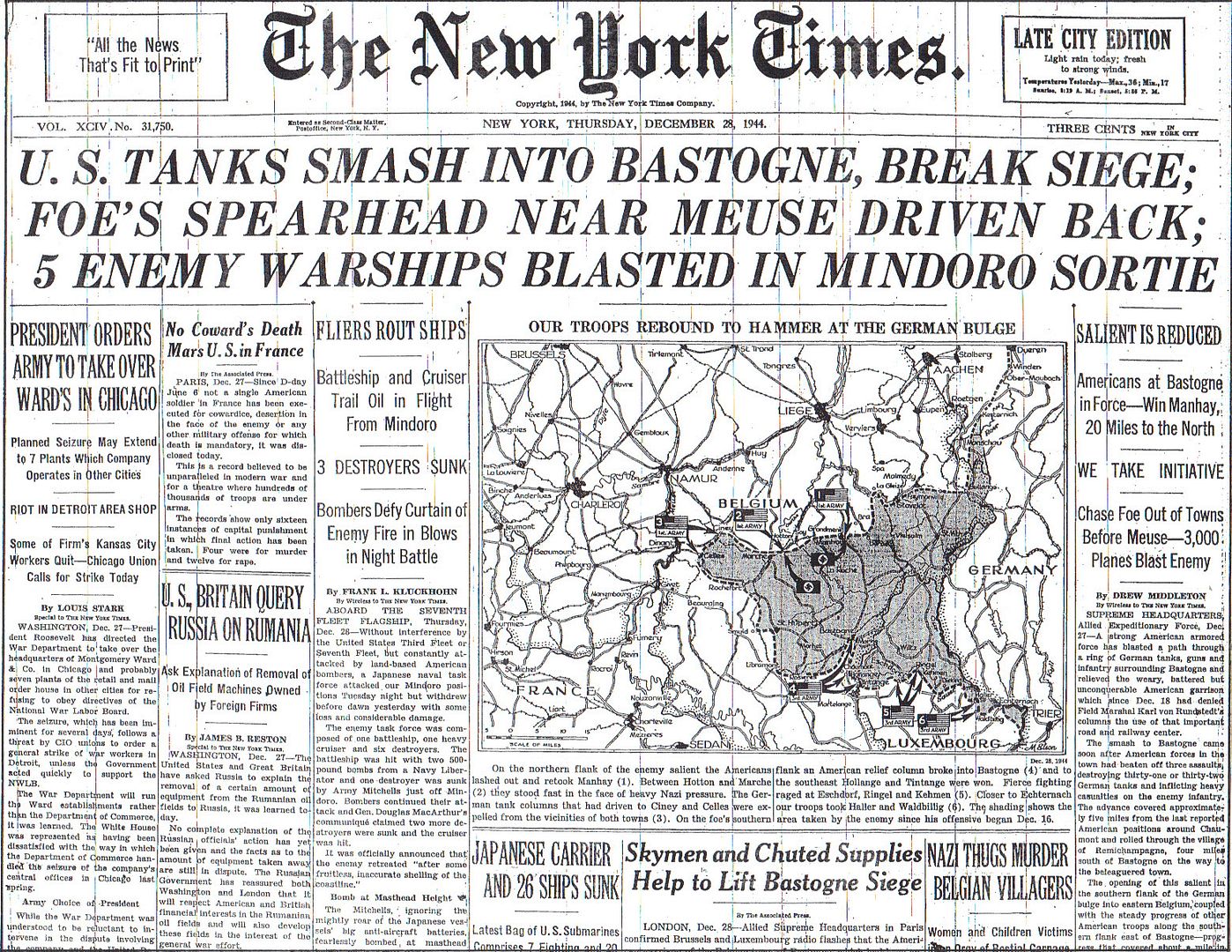
Posted on 12/28/2014 4:33:52 AM PST by Homer_J_Simpson


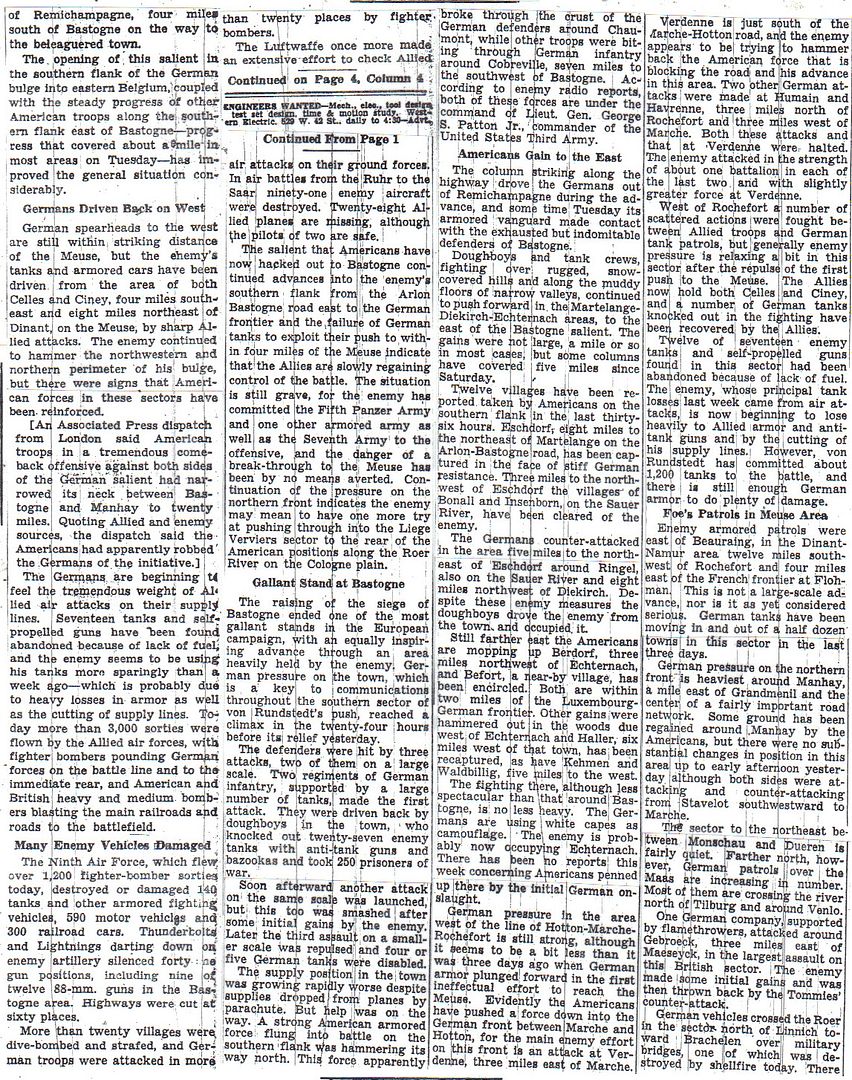

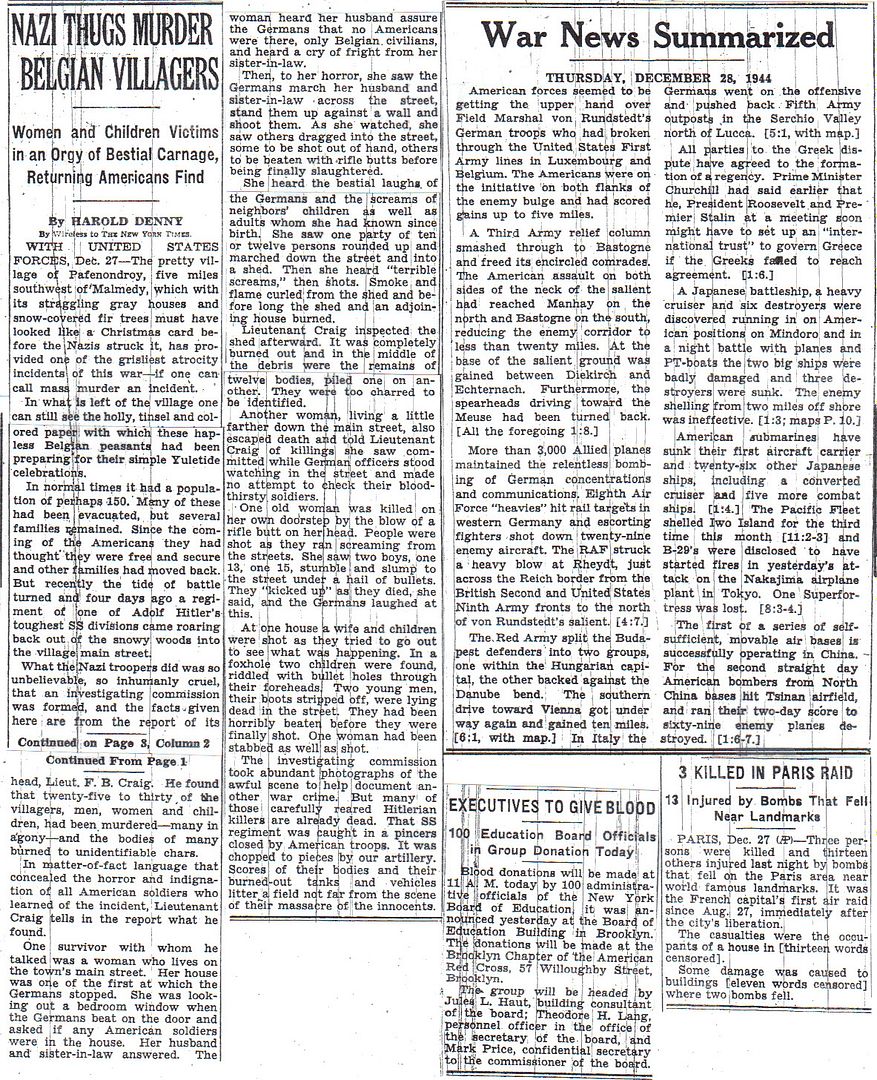
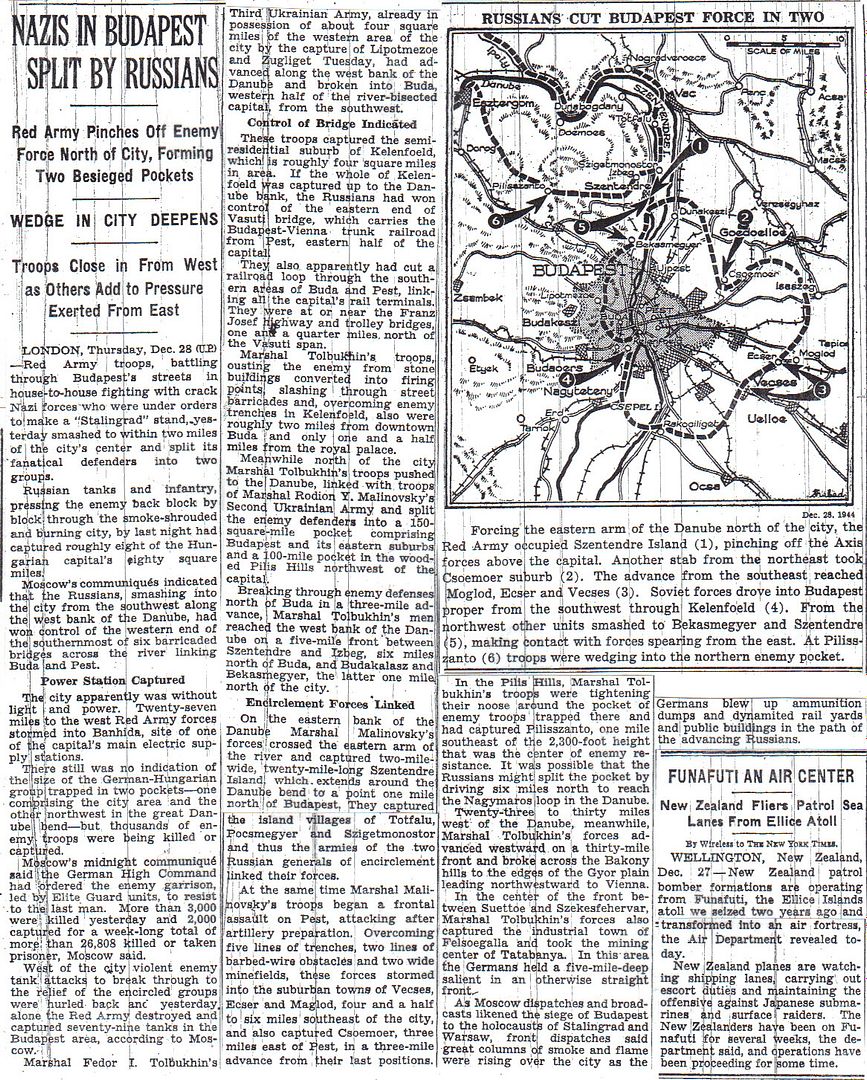

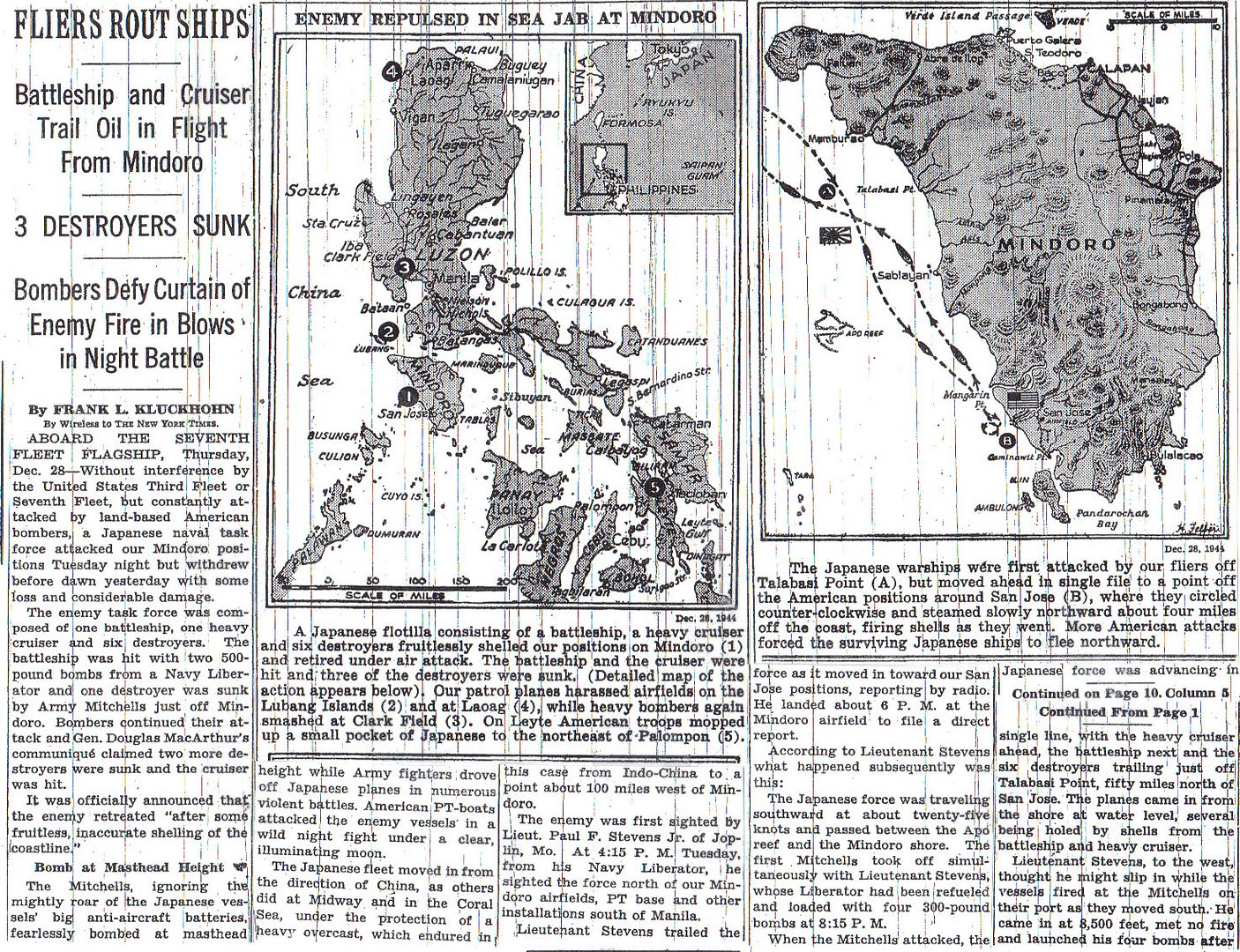
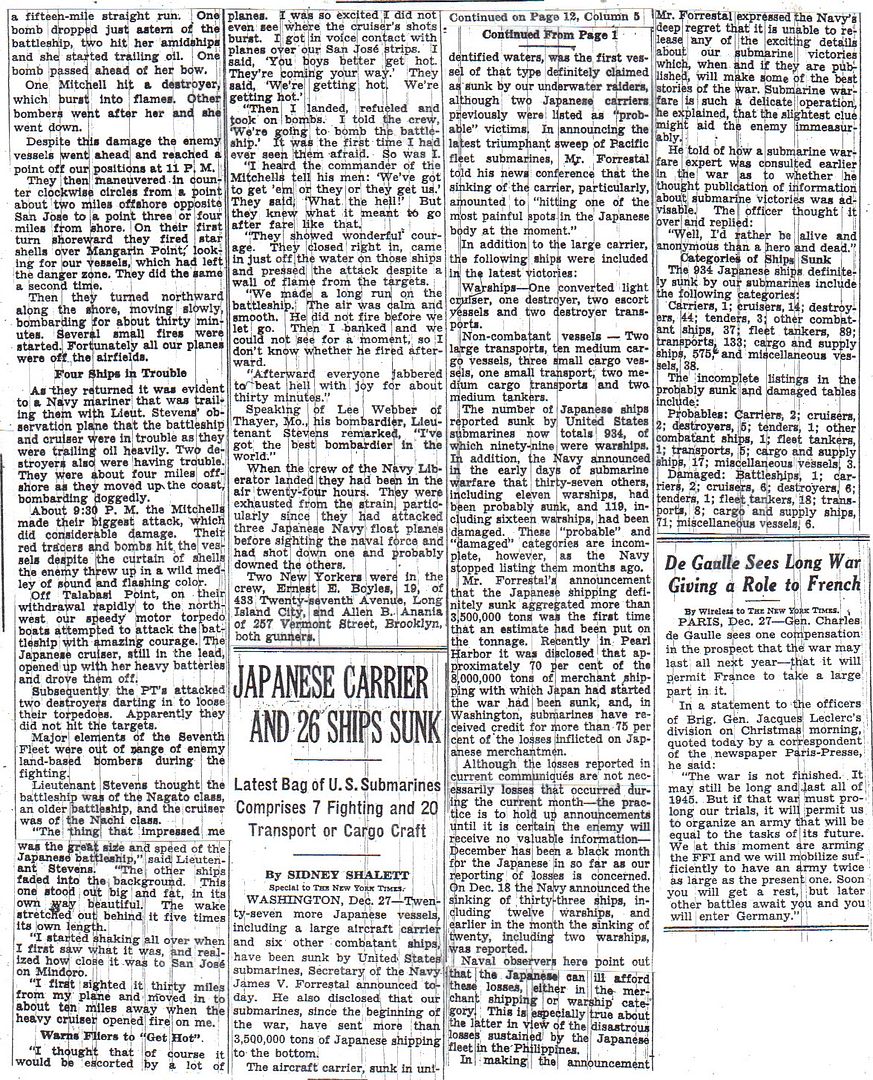
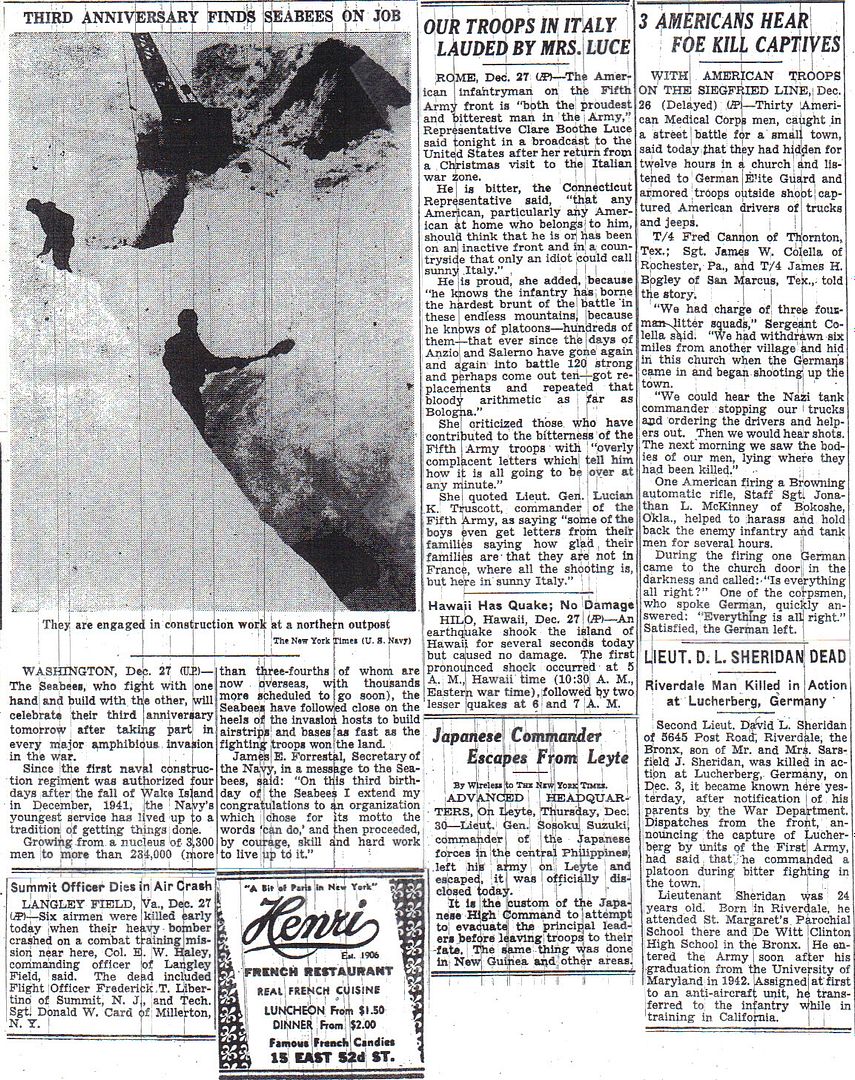
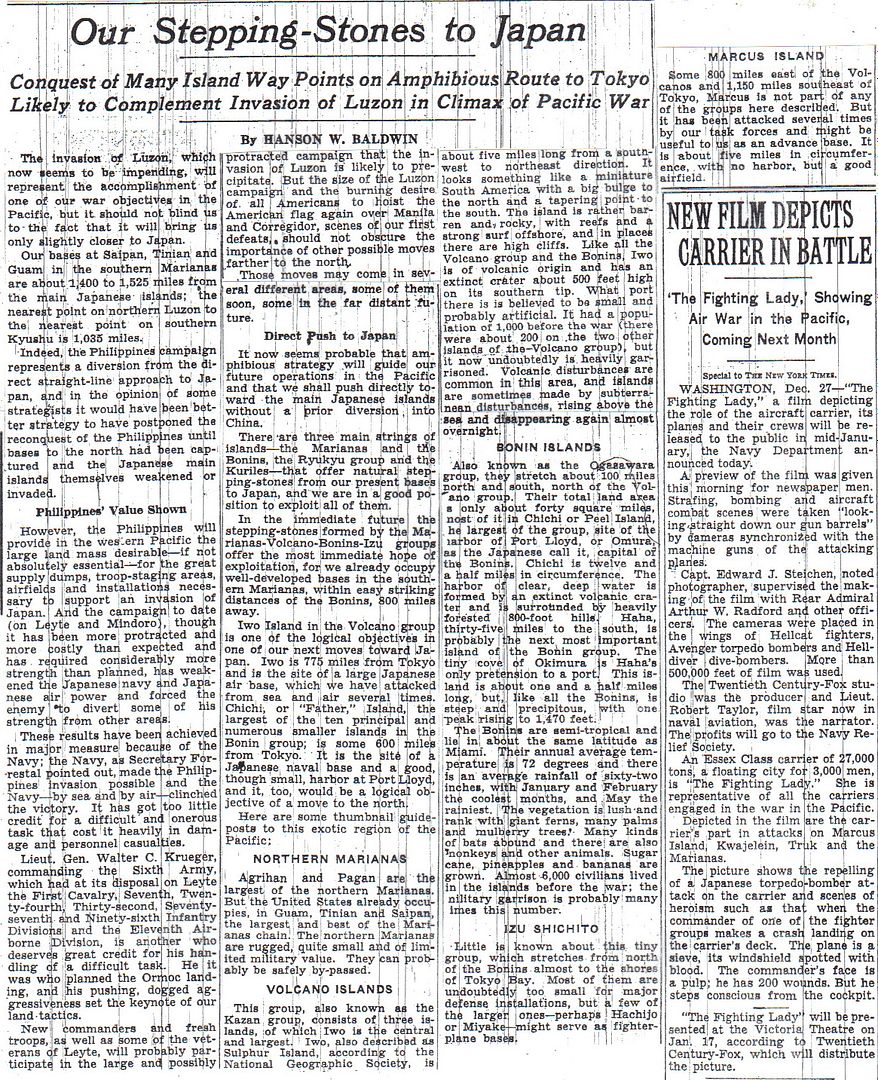

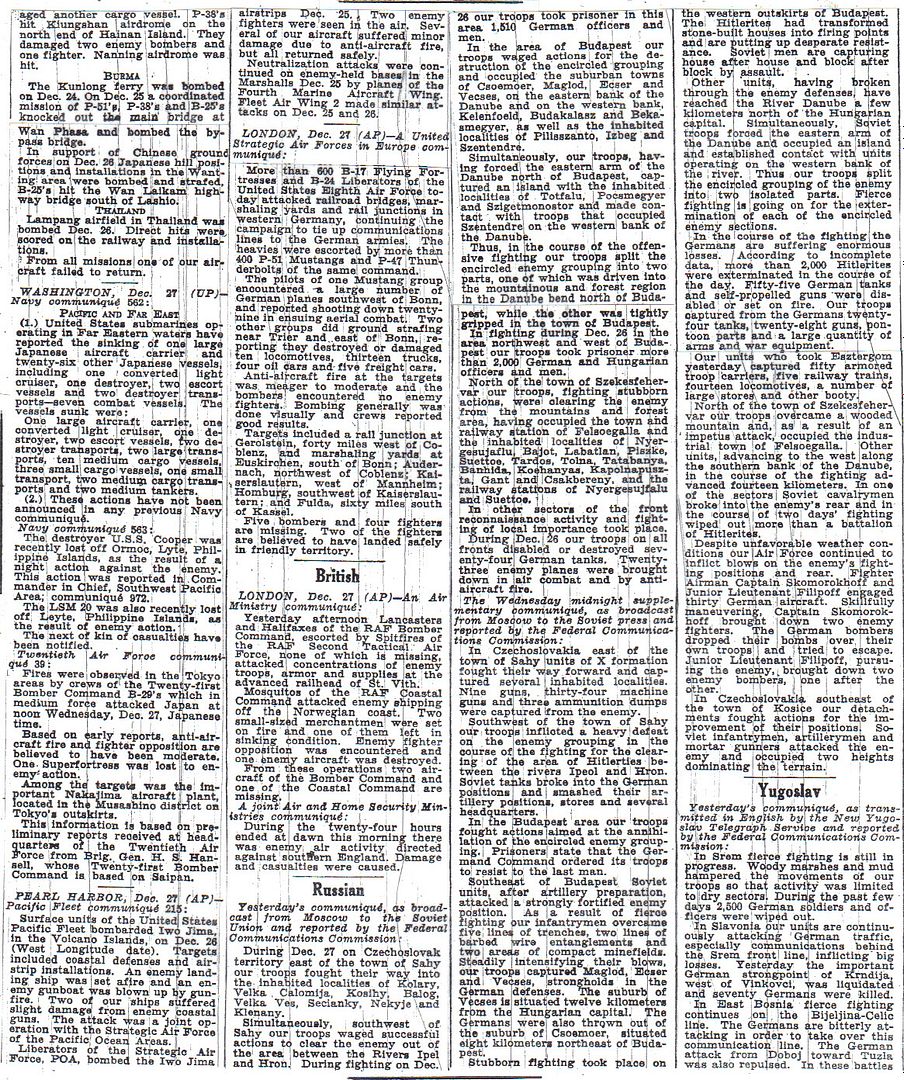
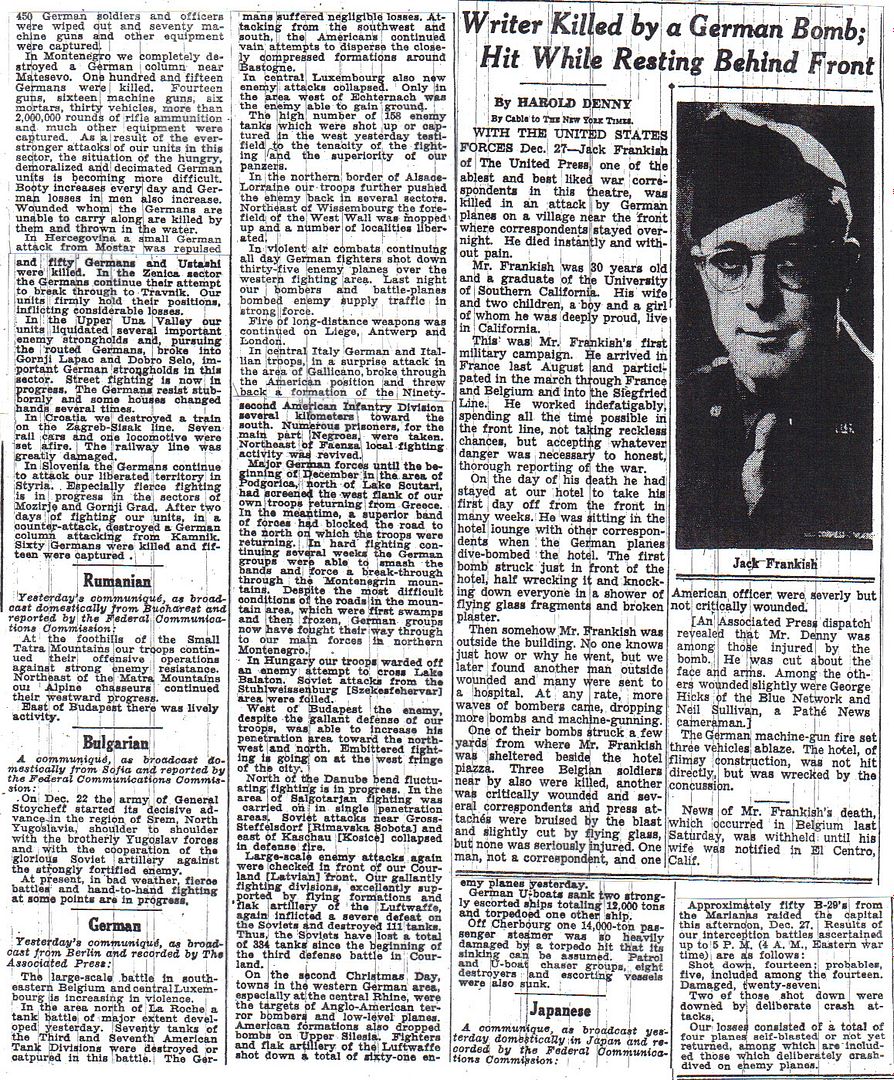
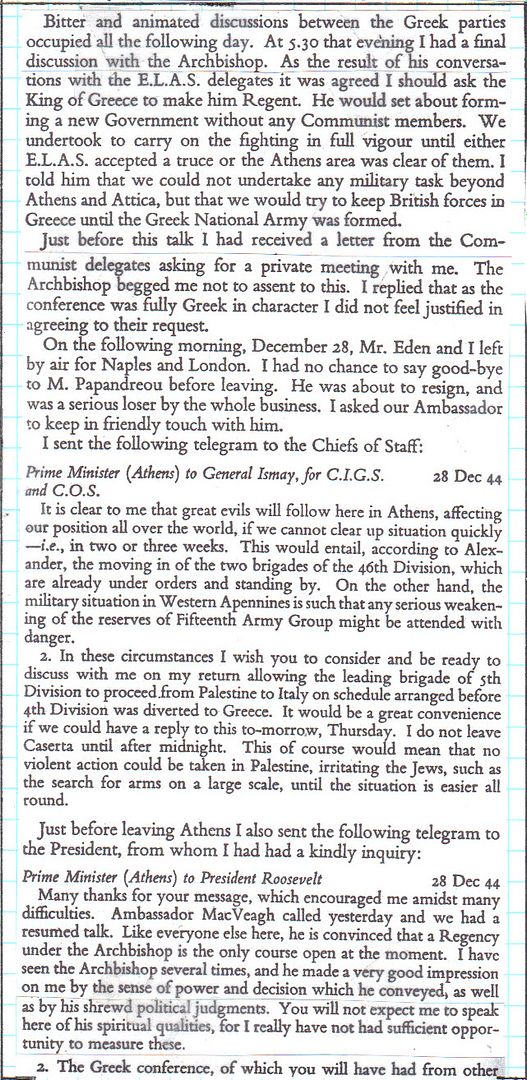
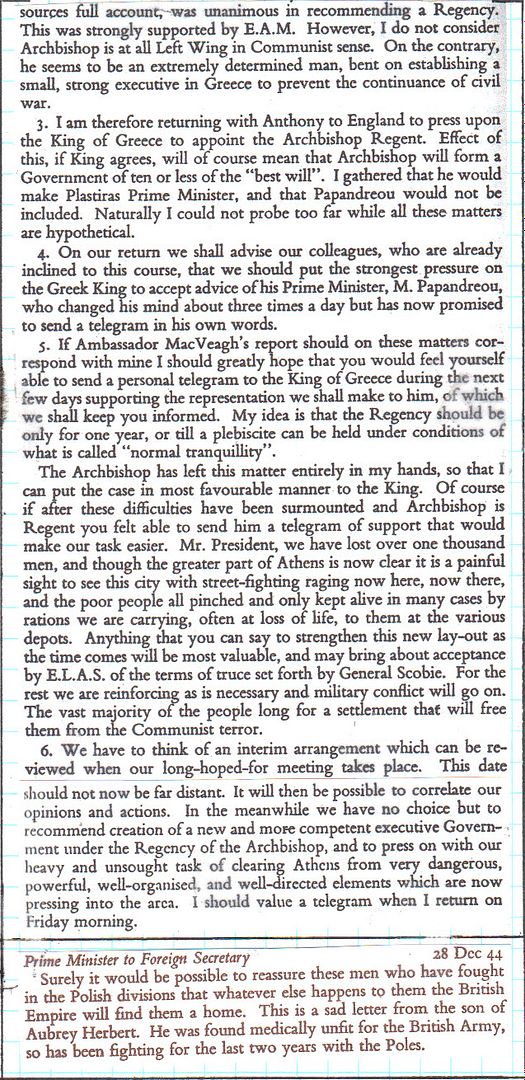
Winston S. Churchill, Triumph and Tragedy
* The whole movie is available at youtube.
http://www.etherit.co.uk/month/11/28.htm
December 28th, 1944 (THURSDAY)
UNITED KINGDOM: Frigate HMS Cardigan Bay launched.
BELGIUM: Eisenhower and Montgomery meet aboard the former’s train in Hasselt. Montgomery is convinced that the Germans have one more full-blooded attack in them. This is probably based upon advice from his Intelligence Officer, Brigadier Williams, who like most intelligence officers at the time was living by the adage, once burned, twice cautious.
ULTRA does not see it this way and Ike is going along with ULTRA. However, Monty does reveal that, while he does expect a blow from the Germans, he is making some preparations for an attack on the Bulge from the north.
The conference ends with Monty, once again, lobbying for his appointment as overall ground force commander. He believe that he has made his point and informs Brooke who does not believe that Ike would appoint a supreme ground commander and that Monty, after rubbing salt into Ike’s wounds, for not having followed his advice, is hearing what he wants to hear from Ike. Monty heard wrong. (Jay Stone)
In the U.S. First Army’s V Corps area, the final German effort to force the 1st Infantry Division from the Elsenborn defenses fails. In the XVIII Corps (Airborne) the area, corps zone is relatively quiet. Combat Command B, 9th Armored Division, and Regimental Combat Team 152 move into position to back up the 3d Armored Division and 75th Infantry Division. In the VII Corps area, the 75th Infantry Division, less Regimental Combat Team’s 289 and 290, is attached to the XVIII Corps. The Germans infiltrating in the sector of Combat Command A, 3d Armored Division take Sadzot but are driven out. The 83d Infantry Division is relieving the 2d Armored Division and takes responsibility for the sector east of the line Buissonville-Rochefort; elements push into Rochefort.
In the U.S. Third Army’s III Corps area, limited progress is made against delaying opposition between the Sauer and Wiltz Rivers. The 35th Infantry Division continues their drive on the southern flank of the German salient despite very heavy fire southwest of Villers-la-Bonne-Eau.
During the night of 28/29 December, the USAAF Eighth Air Force flies Mission 768: two B-24 Liberators drop leaflets in Belgium without loss..
LUXEMBOURG: The 26th Infantry Division makes slight progress toward Wiltz. The XII Corps is ordered on the defensive in afternoon. The 80th Infantry Division repels an attack for Ringel.
GERMANY:
In the U.S. Ninth Army’s XIX Corps area, the 8th Infantry Division completes the reduction of the pocket south of Obermaubach.
The USAAF Eighth Air Force flies Mission 766: 1,275 bombers and 606 fighter are dispatched to hit rail and road bridges and several cities in the western German tactical area; two bombers are lost. The targets are (numbers in parenthesis indicate number of aircraft bombing and number lost, e.g., 97-1):
- Marshalling yards (M/Ys): at Koblenz, the Mosel M/Y (399-0) and the Lutzel M/Y(131-0); Kaiserslautern M/Y (123-2); Bruhl M/Y (75-0); Homburg M/Y (38-0); Siegburg M/Y (36-0); Neuenkirchen M/Y (27-0) and Troisdorf M/Y (11-0).
- Railroad bridges: Neuweid Bridge (109-0); Ludendorf Bridge at Remagen (71-0); Kaiserslautern Bridge (31-0); and Bullay Bridge (20-0).
- Other targets: Rheinbach communications center (34-0); Bierbach city (24-0);; Zweibrucken industrial area (21-0); Pirmasens industrial area (11-0); and miscellaneous (9-0).
USAAF Fifteenth Air Force heavy bombers attack five cities: at Regensburg,106 bomb the Winterhafen oil storage facility with the loss of one aircraft and 29 bomb the marshalling yard (M/Y) with the loss of one; 13 bomb the Main M/Y at Salzburg; 11 bomb the M/Y at Amstetten; and one bombs a target of opportunity.
During the day, RAF Bomber Command sends 167 Lancasters to attack the Gremberg marshalling yards at Cologne; 164 bomb the targets with accurate bombing.
During the night of 28/29 December, RAF Bomber Command dispatches three groups of bombers:
- 186 aircraft, 129 Lancasters, 46 Halifaxes and 11 Mosquitos, bomb the Gladbach marshalling yard at Munchen; 167 hit the target. The railway yards are the aiming point but little damage was caused there.
- 162 Lancasters and 16 Mosquitos are sent to Bonn; 171 attack with the loss of one Lancaster. The intention again is to bomb the railway installations. Bomber Command’s report states that the main weight of the attack falls on the railway yards, causing “considerable damage.”
- 87 Mosquitos to Frankfurt-am-Main, 79 to the city generally and eight to the railway yards; 83 aircraft bomb the targets.
U-3029 launched.
AUSTRIA: USAAF Fifteenth Air Force heavy bombers bomb five targets: six each hit the Kallwing marshalling yard and the railroad bridge at Kammern; four each attack the city of Heiflau and the marshalling yard at Zwettle; and one bombs Knittlefeld.
CZECHOSLOVAKIA: USAAF Fifteenth Air Force heavy bombers bomb six targets: 53 bomb the oil refinery at Pardurice, 48 hit the oil refinery at Kolin; 25 attack oil storage facilities at Roudnice with the loss of two aircraft; 22 bomb an oil refinery at Kralupy; ten bomb the Nymburk railroad bridge at Kammern; and one bombs a target of opportunity.
NORWAY: During the night of 28/29 December, RAF Bomber Command dispatches 67 Lancasters and a Mosquito to attack a “large naval unit” and some merchant ships in Horten harbour in the Oslo fjord. Six of eight German submarines clear the harbour, but U-735 is sunk about 32 nautical miles (60 kilometers) south-southwest of Oslo in position 59.24N, 10.28E; only one of the 40 man crew survives. A second submarine, U-682, suffers heavy damage. (Alex Gordon and Jack McKillop and Dave Shirlaw)
ITALY: The U.S. Fifth Army postpones a projected offensive toward Bologna, the Serchio Valley reversals being a contributing factor. In the IV Corps area, the Germans begin to withdraw in the Serchio Valley, and troops of Indian 8th Division gradually push northward during next few days.
USAAF Twelfth Air Force medium bombers attack troop concentration at Aulla, a dump at Mirabello Monferrato and the viaduct at Borovnica. XXII Tactical Air Command planes support the U.S. Fifth Army in the Serchio Valley, where German counterattacks are repulsed, hit roads and bridges, and destroy a number of vehicles, many at a motor transport depot near Aulla which the fighters bomb and strafe.
USAAF Fifteenth Air Force heavy bombers bomb three targets: 77 bomb the railroad viaduct at Venzone; 50 hit the railroad in the Brenner Pass; and 23 attack a railroad bridge at Bressanone.
During the day, 29 RAF bombers of No. 205 (Heavy Bomber) Group hit the railroad bridge at Casarsa.
During the night of 28/29 December, USAAF Twelfth Air Force A-20 Havocs attack motor transports, ferry crossings, road bridges, rail line, and targets of opportunity throughout northwest and north central Po Valley.
YUGOSLAVIA: USAAF Twelfth Air Force medium bombers attack three rail lines from Austria and Yugoslavia into northeastern Italy by hitting bridges at Bodrez and the viaduct at Borovnica.
During the day, 31 RAF bombers of No. 205 (Heavy Bomber) Group drop supplies to partisans.
GREECE: Athens: A bizarre visit to Athens by Churchill ended today. Foregoing the Christmas celebrations, Mr Churchill and Foreign Secretary Anthony Eden, flew here after a spur of the moment decision to resolve the political crisis which has led to civil war.
In his four days in Athens, the prime minister has had meetings, held by the light of hurricane lamps, with both British-approved Greek politicians and, despite their shellfire outside, representatives from the rebel ELAS movement. His ship, HMS AJAX, has been shelled - returning fire on the PM’s orders - and a guest on the ship, Archbishop Damaskinos, the man favoured as Greek regent, was mistaken for a member of the Ajax’s Christmas fancy-dress party.
During the talks in Athens, British Beaufighters were launching rocket attacks on ELAS a few streets away as the rebels, much to Churchill’s delight, talked of Britain as “our great ally”.
After machine-gun bursts hit the walls of the British embassy above, a snipers bullet narrowly missed the premier. “Cheek!” he said and walked on.
CHINA: Two USAAF Fourteenth Air Force B-25 Mitchells and 16 fighter-bombers hit town areas, railroad targets, and gun positions in the Hengyang-Leiyang area. P-51 Mustangs, P-40s, and P-38 Lightnings on armed reconnaissance over southern China hit targets of opportunity at several locations including areas around Anking, Kinkiang Yungning, Siangtan, and Yuncheng.
BURMA: Twenty three USAAF Tenth Air Force P-47 Thunderbolts knock out a bridge at Nampawng and damage others at Man Pwe and Hsenwi; eight B-25 Mitchells destroy bridges at Kin and Kyaukhlebein, hit an already unserviceable bridge at Padon, damage a bypass road at Lashio and bomb troop concentrations, supplies, and artillery at Mong Hseng, Mong Tat, and Kathe. Four B-25s continue offensive reconnaissance over communications lines during the night of 28/29 December.
USAAF Fourteenth Air Force P-51 Mustangs, P-40s, and P-38 Lightnings on armed reconnaissance hit targets of opportunity around Wanling, Mongyu, Man Pong, and Namtao.
FRENCH INDOCHINA: Twenty USAAF Fourteenth Air Force P-51 Mustangs and P-38 Lightnings attack Gia Lam Airfield pounding the barracks area, hangars, shops, and railroad facilities. Other P-51 Mustangs, P-40s, and P-38 Lightnings on armed reconnaissance hit targets of opportunity around Hanoi and Lang Son.
VOLCANO ISLANDS: Thirteen USAAF Seventh Air Force B-24 Liberators, flying out of Saipan, bomb an airfield on Iwo Jima which is hit again during the night of 28/29 December when B-24 Liberators from Guam and Saipan fly two single-plane strikes.
COMMONWEALTH OF THE PHILIPPINES: On Leyte in the U.S. Eighth Army’s X Corps area, the 5th and 12th Cavalry Regiments (Infantry), 1st Cavalry Division reach the west coast at Tibur, a barrio north of Abijao. The 1st and 2d Battalions, 34th Infantry Regiment, 24th Infantry Division, take San Isidro against light resistance. In the XXIV Corps area, the 2d Battalion, 305th Infantry Regiment, 77th Infantry Division, moves by Landing Craft, Mechanized (LCM) from Ormoc to Palompon; the 3d Battalion continues an overland drive, gaining about 1,000 yards (914 meters).
On Mindoro, Elmore Field is now fully operational.
USAAF Far East Air fighters and bombers on numerous small raids hit targets on Palawan and Mindanao and ,the Lingayen Gulf, and west of Mindoro Island.
EAST INDIES: USAAF Far East Air Forces B-25 Mitchells attack Laha and Kairatoe Airfields on Ambon Island and Haroekoe Airfield on Haroekoe Island while fighter-bombers hit Namlea Airfield on Boeroe (Buroe) Island. In the Soembawa-Flores Island area in the Lesser Sunda Islands, B-24 Liberators attack Japanese shipping. FEAF fighters and bombers on numerous small raids hit targets on Borneo, Celebes, Halmahera, Timor and Tanimbar Islands.
NEW GUINEA: In Northeast New Guinea, the Australian Piper Force Piper Force (two battalions of the 2/11th Battalion, 19th Brigade, 6th Division) occupies the Musimbe area and the 2/8th Battalion, 19th Brigade, 6th Division, concentrates at Luain, 1 mile (1,6 kilometers) east of Suain.
SOLOMON ISLANDS: On Bougainville, Australian Brigadier Raymond Monaghan, General Officer Commanding 29th Brigade, 3rd Division, orders a deep advance along the coast. The 15th Battalion is to seize the south bank of the Tavera Rivera and the log crossing of the Mendai Track north of the river.
PACIFIC OCEAN: Japanese air attacks commence against the 99-ship Mindoro Island, Philippine Island-bound USN Task Group 77.11; Allied air cover cannot be provided because of bad weather over the airfields within range. Kamikazes crash tank landing ship USS LST-750 and U.S. freighters SS William Sharon and SS John Burke. SS John Burke, carrying ammunition, explodes, the cataclysmic blast damaging station tanker USS Porcupine (IX-126) and motor torpedo boat PT-332. There are no survivors from among SS John Burke’s 40-man merchant complement and 28-man Armed Guard. Fragments from John Burke also hit freighter SS Francisco Morozan 100 yards (91 meters) away, wounding three of that ship’s merchant complement. SS William Sharon, set afire by the kamikaze and gutted by fires that are ultimately controlled, is abandoned, the survivors transferring to destroyer USS Wilson (DD-408), whose assistance proves invaluable in extinguishing the blaze that has consumed the freighter. Combat-sa lvage vessel USS Grapple (ARS-7) later tows the merchantman to San Pedro Bay for repairs. USS LST-750, hit subsequently by an aerial torpedo, is consequently scuttled by destroyer USS Edwards (DD-619) off the southwestern coast of Negros Island. Japanese air attacks continue tomorrow.
CANADA: Frigate HMCS Cap de la Madeleine departed St John’s with eastbound Convoy HX-328.
U.S.A.:
Light cruiser USS Providence launched.
Escort carrier USS Rendova launched.
ATLANTIC OCEAN: SS Empire Javelin in a convoy was torpedoed and sunk by U-772 40 miles south of St. Catherine’s Point, Isle of Wight. The U-boat did not report the attack, because she was sunk a short time later, but the time was recorded by the B-Dienst. The master, 121 crewmembers, 28 gunners and all troops were picked up by the Free French frigate L’Escarmouche and landed at Le Havre. Seven crewmembers were lost.
https://jochenpeiper.files.wordpress.com/2014/05/toland_john_battle-story_of_the_bulgebookzz-org.pdf
Because of snow and heavy bombings, Eisenhower’s train didn’t reach Hasselt, Belgium, until noon of December 28. Montgomery greeted him in a chipper, confident manner.
After reviewing the situation and indicating the position of his general reserves, Montgomery walked to a big wall map. “I’m beginning to assemble Collins’ corps once more. When he’s ready I’m having him attack in the general direction of Houffalize.” He pointed to a town fifteen miles north of Bastogne.
Eisenhower brightened.
“But I can’t go over to the attack quite yet.”
“Why not?”
“I’ve just received information the German intends to make at least one more full-blooded smash at my lines. I’m confident I can beat off the attack,” he quickly added, “but I want more time to get my reserve ready to follow in on the heels of the German just as soon as we turn him
back.”
Eisenhower didn’t like the timing of a great counterattack to depend on the action of the enemy. “Don’t you think there’s a good possibility the German might not attack in the north?”
Montgomery shook his head. “I feel it’s a practical certainty.” In any case, he said, he could use the time to reorganize, re-equip, and refresh his troops. He asked if Eisenhower didn’t agree that the first task was to make sure of the integrity of the northern lines?
“Well,” said Eisenhower, “I do agree that the best thing to do is strengthen the front, reorganize your units, and get thoroughly ready for a strong counterblow. In the meantime you’ll be prepared in the event of another German attack.” He paused. “When can you get started?”
“New Year’s Day,” replied Montgomery with no hesitation. And then he added, “Or shortly after—the second or third.”
The meeting was concluded. The men shook hands cordially. Eisenhower had other business.
With the long-awaited northern attack more or less settled, he now had to coordinate it with a strong attack from the south. He dictated a radio message to his chief of staff, Bedell Smith: Release to Bradley at once the 11th Armored and 87th Divisions, and organize a strong Bastogne-Houffalize attack.
“President Orders Army to Take Over Ward’s in Chicago.”
In case we thought all the fighting was in Europe or the Pacific ...
At first glance, I thought it was “wards,” as in election districts, but then I saw the apostrophe and realized it’s the ongoing dispute with the Montgomery Ward company.
Never let a ‘crisis’ go to waste.
War can provide excuses for government intrusions into people’s lives.
WW II went after business and even individuals with rules to shut down live entertainment at midnight so people would sleep and go to work in the morning instead of staying up late, drinking and dancing. Jukeboxes were shut down by government order at midnight, too.
By 1946 all the wartime rules and regulations, food rationing and so on caused a backlash politically with a Republican landslide in the elections.
9-11 gave us NSA data collection, the TSA at airports and so on.
From Atkinson’s The Guns at Last Light
Delayed by fog, snowbanks, and further reports of assassins afoot, Eisenhower’s command train on early Thursday afternoon pulled into a rail siding in the Belgium town of Hasselt, five mile south of Zonhoven. Bodyguards bounded through the station, searching for potential malefactors and machine-gun crews crouched on the platform to lay down a suppressive cross fire, as needed. Montgomery hopped aboard at 2:30 p.m. to find Eisenhower in his study, eager to discuss a counteroffensive that would turn the tables in the Ardennes once and for all. While Smith and De Guingand, the two chiefs of staff, waited in an unheated corridor, Montgomery sketched the plan; four corps would squeeze the enemy salient from the north and northwest, complementing the three already attacking from the south under Patton. The two wings plan to meet in Houffalize, halfway down the length of the bulge.
Yet the field marshal was vague about precisely when this cataclysmic counterblow would fall. Building a combat reserve was vital, Montgomery said. His own direct observation and the reports of his “gallopers” - young British liaison officers who reported to him personally from far corners of the battlefield- led him to conclude that First Army still lacked the strength to confront an enemy force that included at least seven panzer divisions, with enough residual power to launch “at least one more full-blooded attack.” Better to let the enemy first impale himself with a final futile lunge toward the Meuse. Then, deflecting Eisenhower’s impatient request for a date certain, Montgomery urged developments of a “master plan for the future conduct of the war,” one in which “all available offensive power must be allocated to the northern front,” preferably with a single commander who “must have powers of operational control.”
With this ancient theme again resurrected, Eisenhower brought the meeting to a close and showed Montgomery to the platform. Machine-gunners folder up their tripods, bodyguards reboarded, and the train chuffed back to Versailles via Brussels. Despite Montgomery’s insistence that the necessary conditions fall in place before an Allied counterblow was launched, the supreme commander believed that he had extracted a commitment for an attack from the north to begin in four days, on Monday, January 1.
That was incorrect. Montgomery returned to his Zonhoven field camp and cabled Brooke that Eisenhower was “definitely in a somewhat humble frame of mind and clearly realizes that the present trouble would not have occurred if he had accepted British advice and not that of American generals.” He further believed, after a recent conference with Bradley, that the latter also finally recognized the limitations of his generalship. “poor chap,” Montgomery had written Brooke, “he is such a decent fellow and the whole thing is a bitter pill for him.” But 21st Army Group had put the cousins back on track. “We have tidied up the mess,” he told the British chief of staff, “and got two American armies properly organized.” Montgomery also wanted the War Office to know that although he cabled London about his operation each night, no such report went to SHAEF. “You are far better informed, and in the picture, than Ike is,” he confided.
.......continued tomorrow
If things had been left up to Montgomery, it probably would have been a Thousand Year Reich.
The “Nuts” Bastogne reply appears to be first properly reported today on page 4?
The earlier report was of a simple “No” reply...
Montgomery also wanted the War Office to know that although he cabled London about his operation each night, no such report went to SHAEF. “You are far better informed, and in the picture, than Ike is,” he confided.
I believe you are correct. I missed that one. There will be more in a couple days that I did notice.
PB4Y Search Planes flew over IWO JIMA on the 28th day after the second bombardment and noted 12 planes on the South field. Both airfields were reported to be in good condition.
Wondered about the ineffectiveness of the b29 bombing on IWO JIMA.
Maybe the answer is here. They were using Incendiary Bombs? No wonder they didn’t do any real damage.
http://468thbombgroup.org/LinkClick.aspx?fileticket=I8gpYUK3Bhg%3d&tabid=36&mid=467
INCENDIARY CLUSTER BOMBS
The most devastating conventional bomb used by the Americans was the M-69
incendiary cluster. The first B-29 raids against the Japanese mainland were performed in
the fall of 1944, using high-altitude daylight precision bombing with high-explosive
bombs. For several reasons, this strategy proved ineffective, and by the spring of
1945 operations switched to low-level incendiary bombing at night.
The M-69 firebomb had been developed earlier in the war and proved ideal for the task of
burning Japanese cities to the ground. The M-69 was a simple weapon, shaped like a
long tin can and weighing just 2.3 kg (6.2 lb). Since dropping quantities of individual
bombs from high altitude would be wildly inaccurate - it was designed to be incorporated
into an “aim able cluster”, a type of cluster bomb that contained 38 of the M-69
firebombs.
Aim able clusters would be released over the target and break apart at about 900m (2,000
ft) altitude, scattering their M-69s. Each M-69 would then eject a long strip of cloth to
orient itself and crash nose-first into the buildings below. On impact the payload of
napalm would ignite and shoot out of the tail of the bomb in a burning jet. Under ideal
conditions, this jet could extend 45m (100 ft).
NAPALM
Name Type Bomb Wt High Explosives Wt
AN-M30 General Purpose 100 lb 54 lb
AN-M57 General Purpose 250 lb 123 lb
AN-M64 General Purpose 500 lb 262 lb
AN-M65 General Purpose 1,000 lb 530 lb
AN-M66 General Purpose 2,000 lb 1,051 lb
AN-M56 Light Case 4,000 lb 3,245 lb
Name Type Weight Notes
M47A2 Jellied Oil 100 lb Most Widely Used Incendiary by U.S.
M19 Jellied Oil 220 lb Cluster of 36 M69 Dropped in Huge
Numbers During Fire Raids On Japan
You didn’t see the
....continue tomorrow?
Here is a video of the M-69 Bomb. TOTALLY INEFFECTIVE ON IWO!!!!!
Remember the article a few days back about how EVERY major Japanese city had block wide firebreaks. Not effective there either.
https://www.youtube.com/watch?v=uPteVZyF4U0
ok, may have to eat my words. Lemay and the M-69 and low level bombing may have arrived as a team. But WHY were the general purpose bombs so ineffective?
http://en.wikipedia.org/wiki/Bombing_of_Tokyo
The high altitude bombing attacks using general purpose bombs were observed to be ineffective by USAAF leaders. Changing tactics to increase the damage, Curtis LeMay ordered the bombers to drop incendiary bombs to burn Japan’s vulnerable wood-and-paper buildings.[7] The first such raid was against Kobe on 4 February 1945.
Disclaimer: Opinions posted on Free Republic are those of the individual posters and do not necessarily represent the opinion of Free Republic or its management. All materials posted herein are protected by copyright law and the exemption for fair use of copyrighted works.